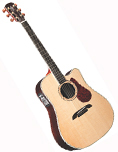Alvarez Yairi Masterworks DYM95C Aura Acoustic


THE ALVAREZ YAIRI masterworks DYM95C Aura appears to be an entirely traditional acoustic guitar with a built-in preamp. But take a closer look and you'll see something surprising: the preamp is, in fact, digital. Moreover, it is a special onboard version of Fishman's Aura Sound Imaging System, which recreates a guitar's natural tone as if it were captured with a high-quality microphone. (The DYM95C is actually one of four Yairi models that include the Aura preamp.)
Considering that digital technology is shrinking, in both physical size and cost, perhaps it was only a matter of time before someone got the bright idea to place a digital preamp in an acoustic guitar. How well does it work? Let's find out.
FEATURES
First off, let's consider the Yairi itself. A fine piece of craftsmanship, the Japanese built Masterworks DYM95C is an elegant single-cutaway dreadnought boasting solid rosewood back and sides and a solid spruce top. A 25 3/8-inch ebony fingerboard caps the mahogany neck. Overall, the look is minimalist clean: handsome inlays add a touch of character at the rosewood-capped headstock, the 12th fret, and around the soundhole, while the distinctive cream wood binding enhances the guitar's contrasting dark and light colors. So far, so good.
FISHMAN AURA PREAMP
Fishman's Aura Sound Imaging System is not a typical preamp or effect device. Rather, the Aura-which I've previously tested in its standalone stomp box form-processes the output of an acoustic guitar's pickup and uses complex imaging to replicate the sound of a miked guitar. With the standalone Aura, you tell the preamp what kind of guitar you're playing and it processes the signal to sound as your guitar would if it were captured by a specific mic. But it also offers the ability to morph your guitar's tone into something resembling a different model of guitar entirely.
The onboard Aura isn't as extreme, yet it's more effective simply because it's pretuned to work with the Yairi's natural acoustic tone as captured by its bridge piezo. It generates images of the Yairi captured by a number of different mics at various distances, but it doesn't try to morph the instrument into a different guitar, nor should it, since the Yairi sounds great on its own. Rather, the goal is to create a range of good direct sounds for this premium guitar and make them easily accessible onstage and in the studio. Furthermore, the Aura signal can be blended with the unaffected piezo signal to provide a broad range of tone colors.
The Aura has six presets based on mics from the likes of Neumann, Soundelux, Shure and Earthworks. The sound images are positioned between four inches and four feet from the guitar, though most of the images were created using condenser mics 16 inches away. These images can be tweaked slightly with the three-band EQ, and these settings can be stored for later recall.
The blend control determines the mix between the images and the onboard piezo, which, it's worth noting, sounds quite good alone. There's an onboard chromatic tuner and a master volume control.
Get The Pick Newsletter
All the latest guitar news, interviews, lessons, reviews, deals and more, direct to your inbox!
PERFORMANCE
On its own, the Masterworks DYM95C performed as one would expect of a guitar in its class. The action was low and comfortable, and intonation was excellent up and down the neck. Most important, the Yairi's tone was bold, balanced, rich and full of overtones. It was equally adept at spirited strumming and sensitive single-note expression.
As with the standalone Aura, I liked the sound best when I blended the image with the pickup. Alone, the Aura processed sound can be distant and a little "digital," and I found that Aura-to-pickup blends in the range from 20/80 to 50/50 sounded most natural. Numerous other features played a significant role in shaping the sound. The onboard phase switch allowed me to create a fuller sound, the EQ was effective, and the feedback eliminator and onboard chromatic tuner were handy as well.
The Aura is an excellent alternative to a conventional piezo or a piezo/mic blender system. It is not only more flexible but also less prone to feedback or bleed than the mic, making it a more practical choice in most live situations. In the studio, it provides excellent direct sound. Ideally, I would still add in the sound of a top-quality mic when available, but under many conditions, I wouldn't hesitate to go direct with the Yairi for featured tracks.
THE BOTTOM LINE
Fifteen years ago, the Masterworks DYM95C would have been the kind of guitar that called for the best studio mics. Today, thanks to the Aura, it can deliver something very close to studio-miked sound via its preamp. This may well be the future of onboard guitar electronics.
The heaviest acoustic guitar ever made? Two budding builders craft an acoustic entirely from concrete because they “thought the idea was really funny”
“For years, the only 12-string acoustics I got my hands on, the necks always pulled off after a bit. I earned a lot of money replacing them!” Why one of the UK’s most prolific luthiers is a bolt-on acoustic die-hard










